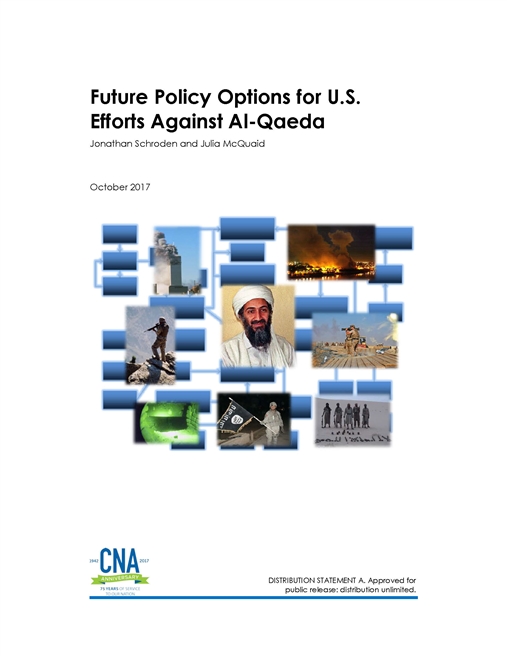Section 1228 of the 2015 National Defense Authorization Act (NDAA) stated, “The Secretary of Defense, in coordination with the Secretary of State and the Director of National Intelligence, shall provide for the conduct of an independent assessment of the effectiveness of the United States’ efforts to disrupt, dismantle, and defeat Al- Qaeda, including its affiliated groups, associated groups, and adherents since September 11, 2001.” The Assistant Secretary of Defense for Special Operations/Low Intensity Conflict (ASD SO/LIC) asked CNA to conduct that independent assessment, which CNA published in August 2017.
As part of that assessment, we examined:
- The evolution of Al-Qaeda’s strategy, organization, capabilities, and relationships over the past two decades
- The evolution of the security environments in which Al-Qaeda’s “core” group and its declared affiliates have operated or sought to operate, and how these groups have exploited worsening conditions in those environments
- The evolution of the U.S. government’s approaches to Al-Qaeda and what aspects of those approaches have been most and least effective.
We then analyzed the results of our research on these three topics to assess where the U.S. stood with respect to its stated policy goals for Al-Qaeda—namely, to disrupt, dismantle, and defeat the organization. We concluded the following:
- Current U.S. efforts are aligned more closely with the direct threat that Al- Qaeda poses to the United States and less closely with the security conditions, or vulnerabilities, that Al-Qaeda exploits to survive and expand.
- U.S. government efforts to date have not defeated Al-Qaeda. The current U.S. strategy—centered on military approaches and anchored in the assumed linear goals of disrupting, dismantling, and defeating the organization—is unlikely to do so.
- Dismantling Al-Qaeda would entail a commitment of U.S. resources well beyond those committed today.
- Continued disruption of Al-Qaeda is likely to require increasing resources as security environments continue to weaken in many parts of the world where Al-Qaeda operates and seeks to operate.
Based on these findings, we assessed that the current U.S. strategy toward Al-Qaeda is unlikely to attain the United States’ desired goals. Therefore, we recommended that the U.S. government undertake a new review of its policy goals and overarching strategy against Al-Qaeda.3 Using the findings from our independent assessment as a starting point, we present in this occasional paper our thoughts on a set of options that the U.S. might consider as part of such a policy review. We will discuss three distinct options: retrenchment, escalation, and containment.
To be clear, we recognize that there are other options available to the U.S. government beyond these three choices. And we recognize that Al-Qaeda (and like organizations, such as the Islamic State of Iraq and Syria, or ISIS) is not a singular group and so it may be possible—or even advantageous—to apply a mix of these options to various parts of the Al-Qaeda organization. But these three options are worth considering as a starting point for a renewed discussion on the United States’ strategy toward Al-Qaeda, as they represent a range of options with distinct advantages and disadvantages relative to each other and to the current U.S. strategy. Our intent in presenting these options is to provide the U.S. government with a structured foundation from which to launch an effort to devise a new strategy for its approach to Al-Qaeda.
In the remainder of this paper, we will first briefly summarize the current state of Al- Qaeda, the security environment in which it operates, and the U.S. government’s efforts against the group. We will then discuss the three policy options in turn, and end with some concluding thoughts as to the way ahead.
Download reportDISTRIBUTION STATEMENT A. Approved for public release: distribution unlimited.
Details
- Pages: 40
- Document Number: DOP-2017-U-016307-1Red
- Publication Date: 10/25/2017
